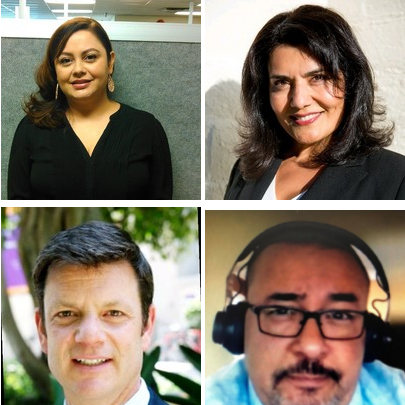“You can’t fight a pandemic on an empty stomach”
By: Mark Hedin, Ethnic Media Services
Los Angeles County officials’ cautious optimism about the battle against COVID-19 is tempered with a warning: People must stay vigilant about taking precautions while pandemic vaccination and assistance programs expand.
“We continue to make progress in reducing the average number of daily new cases,” said Dr. Eloisa Gonzalez, director of integrative medicine at Historic General Hospital’s Wellness Center at a Feb. 25 press briefing.
That reduction in cases has allowed some schools to begin reopening, making it possible for a more adults to get back to work, too, Gonzalez said.
“But our numbers remain elevated,” she cautioned.
Despite vaccine production and distribution ramp ups and the development of new vaccines, inequities in who’s getting those vaccines persists, Gonzalez said.
Almost 48% of white and 45% of Asian American seniors eligible to be vaccinated have had at least one dose already, she reported. But among American Indian and Alaska Natives, that number drops to 38.4%. Among Latinx communities, it’s 34.3% and in the African American community, 28.9%.
To address inequities, Gonzalez said, the county is working with community groups to register people for their vaccines and adding new vaccination sites to the more than 400 already open.
The three speakers who followed Gonzalez addressed Los Angeles County’s other major challenge in the continuing COVID crisis — food insecurity brought on by the economic crisis.
Gary Gero, director of the county’s Emergency Food Security Branch, said
that in this county of 10 million people, one in three report having struggled in the last year to have enough food to feed themselves and their families.
Those numbers are worse in ethnic communities. Among Latinix age 18-40 with kids and without college degrees, for example, 45% are experiencing food insecurity.
“You can’t fight a pandemic on an empty stomach,” Gero said. “We are absolutely committed to putting food on the tables of our most vulnerable residents.”
He endorsed the U.S. Department of Agriculture’s WIC program (Special Supplemental Nutrition Program for Women, Infants, and Children), which helps provide
baby formula and foodstaples (https://tinyurl.com/WICchoices) and is available to everyone, regardless of citizenship or immigration status.
You can apply for WIC here: https://tinyurl.com/getWIC.
Also, Gero said, the county board of supervisors has allocated $135 million of County Cares Act funds to provide food support, and is partnering with Los Angeles Regional Food Banks, the school district and community organizations to do more.
New drive-through pickup distribution is helping offset the problem of many food banks and pantries having to close because their space was too small or they had too few volunteers to continue amid COVID-related safety concerns. Dates and locations are posted at (https://tinyurl.com/LAdriveupfoodbox)
The drive-up locations are established wherever the need seems greatest in the county, Gero said. So far, 9 million pounds of food have been distributed in 50-pound bundles placed into car trunks at those sites. Food banks and distribution sites have no eligibility requirements and, like WIC, are available to anyone.
Other sites for food and supplies can be found by visiting the county website: https://covid19.lacounty.gov/food/or calling 2-1-1.
Abraham Gomez, manager of the county Department of Social Services’ CalFresh program, noted a 179% spike in applications for so-called “food stamps” between April 2019 and April 2020, following the shelter-in-place order.
CalFresh, known in its federal version as SNAP (Supplemental Nutrition Assistance Program), has eligibility requirements, but non-citizens can apply on behalf of children born in the United States. The county estimates that 400,000 eligible households have not applied, he said.
“We have to increase participation (https://www.getcalfresh.org/) and awareness,” Gomez said. “Things are going to get better.”
The press briefing’s final speaker, Elizabeth Cervantes, a veteran of 19 years with the Los Angeles Regional Food Bank, said new partnerships with the county and the Los Angeles school district have helped meet a 145% increase in demand from pre-pandemic levels for staples such as cereal, rice, beans, soup, peanut butter.
But she hears now from “families who never thought they’d need help: recently unemployed or furloughed workers, who really didn’t think they would ever be in this situation, from all ethnic groups, but in the majority from ethnic communities.”
Gonzalez had opened the panel with promising news: The number of new daily COVID cases have fallen to a tenth of what it was in early January.
“There is no shortage of heroes here in Los Angeles County,” she said, but warned: “This significant drop wasn’t a miracle. It reflects continuous actions and choices by millions of residents, workers and employers.”
“Remain vigilant,” Gero agreed. Change, he said, “is not going to be like a light switch.”
Photo Caption: Clockwise from top left: Elizabeth Cervantes, Director of Agency Relations and Product Acquisitions, Los Angeles Regional Food Bank; Eloisa Gonzalez, MD, MPH, Director of Integrative Medicine at the Wellness Center at LAC+USC Historic General Hospital, spokesperson for the COVID-19 vaccine for Spanish-language media; Abraham Gomez, CalFresh Program Manager, LA County Dept of Public Social Services; Gary Gero, Director of Los Angeles County’s Emergency Food Security Branch






